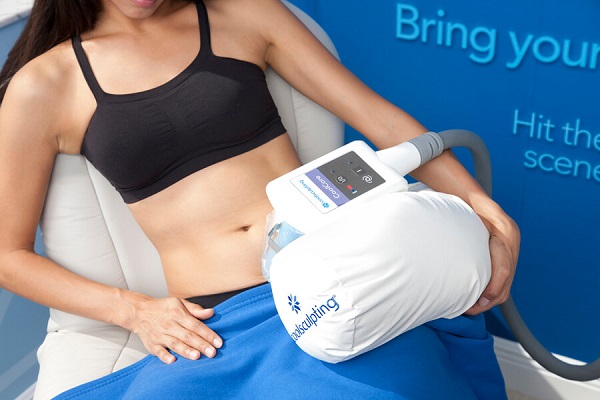Wondering about the factors involved in CoolSculpting such as the relative safety, economic benefits, or recovery time required for CoolSculpting? Learn all about it in this post.
What Is CoolSculpting?
CoolSculpting is a nonsurgical procedure performed to reduce fat in a specific area of the human body. The procedure was approved by the Food and Drug Administration in 2012 and the procedure has been used in more than four million cases around the world.
CoolSculpting does not require anesthesia and is not invasive. CoolSculpting is based on the scientific process of cryolipolysis that is the use of cold temperatures to freeze and destroy fat cells on the patient’s abdomen, sides, upper arms, chin, and thighs.
How Is It Done?
The procedure is performed by a doctor or trained healthcare provider under the supervision of a doctor. The provider uses a handheld device that looks like a vacuum cleaner’s attachments, which delivers a controlled amount of cooling to a gel pad to the targeted area of fat. The cellular response to the cold is to break down fatty tissue through extracting energy to the layers of fat causing the fat cells to die, without damaging nerves, muscles or other tissues in the area around the fat cells. The treatment typically takes three hours or less, during which the patient will commonly feel some minimal discomfort with pulling and pinching sensations.
Who Is a Good Candidate for the Procedure?
The preferred candidate for the procedure is generally someone who is within 20 pounds of their ideal body weight and not suffering from any significant physical conditions.
CoolSculpting is not used as a weight loss procedure. Patients should not be pregnant and have enough fat in the area to be treated. For patients that eat a healthy and balanced diet and exercise regularly, but still have those areas of fat deposits that are just plain stubborn and refuse to shrink, CoolSculpting provides a safe and effective way to reduce fat and achieve a natural-looking result in conjunction with anti aging treatments.
What Are the Benefits of CoolSculpting?
The benefits of CoolSculpting, as opposed to other procedures such as liposuction, are that it is a non-invasive and non-surgical procedure. The procedure as approved by the Federal Drug Administration is considered a safe and effective alternative treatment for fat reduction.
For many people, the idea of going “under the knife” to remove stubborn fat is a step too far, and CoolSculpting allows for the removal of this stubborn fat through a simple procedure that’s akin to a treatment at a spa.
A big advantage of CoolSculpting is that it does not require anesthesia or needles of any type. Since CoolSculpting is a non-surgical and non-invasive treatment, it requires no downtime or recovery time.
Generally, the treatments are of rather short duration and the patient and their health care provider will plan a course of treatment over a period to reduce fat in the target areas over a series of appointments. Most patients are able to go back to work immediately after their treatment.
Additionally, the treatment is a highly effective process as it accounts for differences in the different body types of each individual patient and provides natural-looking results. Most patients start to see tangible results from the treatment within three to four weeks. Over the longer treatment period, the patient will see much more dramatic results within a six-month period.
One of the biggest benefits is that the treatment is permanent because the fat cells have been destroyed, absorbed, and eliminated by the body.
Cost Considerations of CoolSculpting
CoolSculpting is also considered to be an economical alternative to other fat reduction procedures such as surgery or liposuction with the cost of CoolSculpting starting at as little as $750 for one area of treatment and typically being less than $2,000, while liposuction treatment starts at about $2,500 and can range up to $5,000 for one area of treatment.
And of course, the cost of CoolSculpting is substantially less than surgical alternatives with costs for surgery that require operating rooms and anesthesia and can cost $10,000 or more.
The cost for CoolSculpting is generally not covered by health insurance — but the costs of liposuction and most weight-loss surgeries are also not covered by health insurance as they are considered cosmetic procedures or not medically necessary.
Conclusion
When considering all of the factors involved such as the relative safety, the economic benefits, and the lack of downtime or recovery time required for CoolSculpting as opposed to alternative treatments, it is apparent that it should be a preferred treatment for patients that are good candidates for CoolSculpting.
More Information About CoolSculpting
A very useful and informative post! I have never heard of this before!
I like how you mention the ideal candidate for coolsculpting is someone who is near there goal weight within twenty pounds and not suffering from any major physical conditions. My sister has been wanting to try coolsculpting but was curious if she should be worried about it working for her. I think that since she is a runner and has no other physical conditions she would be a great candidate and that coolsculpting could be a great solution for her.
It’s good that you point out that Coolsculpting is a non-invasive procedure for reducing fat. My wife is very concerned about maintaining her figure, and I’m considering recommending Coolsculpting to her. I’m going to look for a good clinic that offers Coolsculpting in my area.